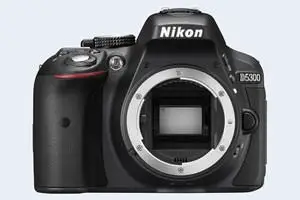Canon SX730 vs Nikon D5300
The Canon PowerShot SX730 HS and the Nikon D5300 are two digital cameras that were revealed to the public, respectively, in April 2017 and October 2013. The SX730 is a fixed lens compact, while the D5300 is a DSLR. The cameras are based on a 1/2.3-inch (SX730) and an APS-C (D5300) sensor. The Canon has a resolution of 20.2 megapixels, whereas the Nikon provides 24 MP.
Below is an overview of the main specs of the two cameras as a starting point for the comparison.

Check SX730 offers at
ebay.com

Check D5300 offers at
ebay.com
Going beyond this snapshot of core features and characteristics, what are the differences between the Canon PowerShot SX730 HS and the Nikon D5300? Which one should you buy? Read on to find out how these two cameras compare with respect to their body size, their imaging sensors, their shooting features, their input-output connections, and their reception by expert reviewers.
Body comparison
The side-by-side display below illustrates the physical size and weight of the Canon SX730 and the Nikon D5300. The two cameras are presented according to their relative size. Three consecutive perspectives from the front, the top, and the back are available. All width, height and depth measures are rounded to the nearest millimeter.
The SX730 can be obtained in two different colors (black, silver), while the D5300 is available in three color-versions (black, grey, red).
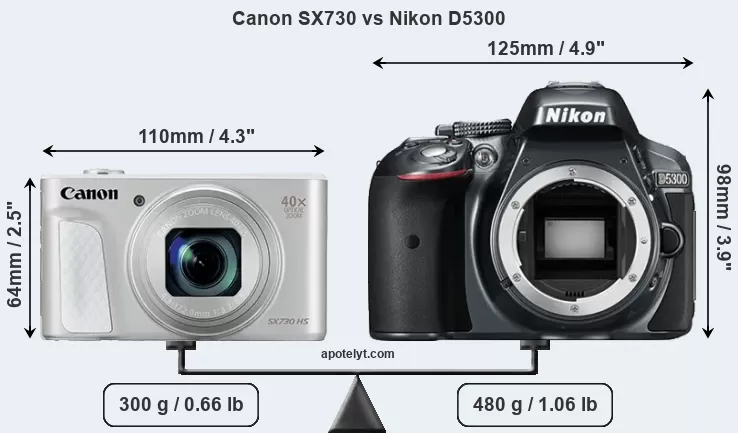
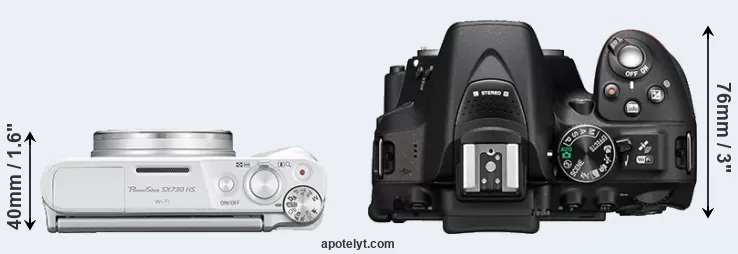
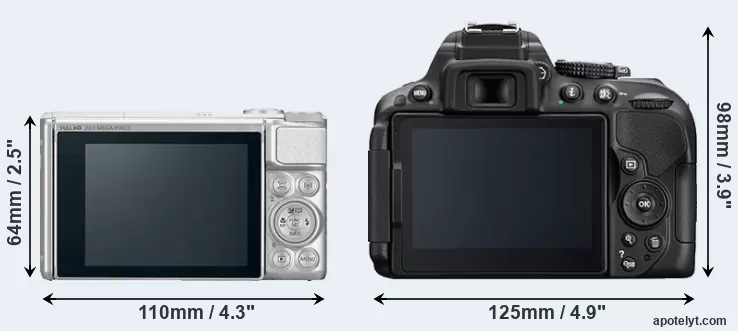
If the front view area (width x height) of the cameras is taken as an aggregate measure of their size, the Nikon D5300 is considerably larger (74 percent) than the Canon SX730. In this context, it is worth noting that neither the SX730 nor the D5300 are weather-sealed.
The above size and weight comparisons are to some extent incomplete and possibly misleading, as the SX730 has a lens built in, whereas the D5300 is an interchangeable lens camera that requires a separate lens. Attaching the latter will add extra weight and bulk to the setup. You can compare the optics available for the D5300 and their specifications in the Nikon Lens Catalog.
Concerning battery life, the SX730 gets 250 shots out of its Canon NB-13L battery, while the D5300 can take 600 images on a single charge of its Nikon EN-EL14a power pack. The power pack in the SX730 can be charged via the USB port, so that it is not always necessary to take the battery charger along when travelling.
The table below summarizes the key physical specs of the two cameras alongside a broader set of comparators. If you want to switch the focus of the display and review another camera pair, you can move across to the CAM-parator tool and choose from the broad selection of possible camera comparisons there.

| Camera Model |
Camera Width |
Camera Height |
Camera Depth |
Camera Weight |
Battery Life |
Weather Sealing |
Camera Launch |
Launch Price (USD) |
Street Price |
||
|---|---|---|---|---|---|---|---|---|---|---|---|
| 1. | Canon SX730 | 110 mm | 64 mm | 40 mm | 300 g | 250 | n | Apr 2017 | 399 | ebay.com | |
| 2. | Nikon D5300 | 125 mm | 98 mm | 76 mm | 480 g | 600 | n | Oct 2013 | 799 | ebay.com | |
| 3. | Canon G7 X Mark II | 106 mm | 61 mm | 42 mm | 319 g | 265 | n | Feb 2016 | 699 | ebay.com | |
| 4. | Canon SX420 | 104 mm | 69 mm | 85 mm | 325 g | 195 | n | Jan 2016 | 299 | ebay.com | |
| 5. | Canon SX430 | 104 mm | 69 mm | 85 mm | 323 g | 195 | n | Jan 2017 | 299 | ebay.com | |
| 6. | Canon SX540 | 120 mm | 82 mm | 92 mm | 442 g | 205 | n | Jan 2016 | 399 | ebay.com | |
| 7. | Canon SX710 | 113 mm | 66 mm | 35 mm | 269 g | 230 | n | Jan 2015 | 349 | ebay.com | |
| 8. | Canon SX720 | 110 mm | 64 mm | 36 mm | 270 g | 250 | n | Feb 2016 | 379 | ebay.com | |
| 9. | Canon SX740 | 110 mm | 64 mm | 40 mm | 299 g | 265 | n | Jul 2018 | 399 | amazon.com | |
| 10. | Nikon D3200 | 125 mm | 96 mm | 77 mm | 505 g | 540 | n | Apr 2012 | 599 | ebay.com | |
| 11. | Nikon D3300 | 124 mm | 98 mm | 76 mm | 430 g | 700 | n | Jan 2014 | 499 | ebay.com | |
| 12. | Nikon D5200 | 129 mm | 98 mm | 78 mm | 555 g | 500 | n | Nov 2012 | 749 | ebay.com | |
| 13. | Nikon D5500 | 124 mm | 97 mm | 70 mm | 470 g | 820 | n | Jan 2015 | 899 | ebay.com | |
| 14. | Nikon D5600 | 124 mm | 97 mm | 70 mm | 465 g | 970 | n | Nov 2016 | 699 | ebay.com | |
| 15. | Panasonic TS7 | 117 mm | 76 mm | 37 mm | 319 g | 300 | Y | May 2018 | 449 | ebay.com | |
| 16. | Panasonic ZS70 | 112 mm | 67 mm | 41 mm | 322 g | 380 | n | Apr 2017 | 449 | ebay.com | |
| 17. | Sony HX99 | 102 mm | 58 mm | 36 mm | 242 g | 370 | n | Aug 2018 | 449 | ebay.com | |
| Note: Measurements and pricing do not include easily detachable parts, such as add-on or interchangeable lenses or optional viewfinders. | |||||||||||
The price is, of course, an important factor in any camera decision. The listed launch prices provide an indication of the market segment that the manufacturer of the cameras have been targeting. The SX730 was launched at a lower price than the D5300, despite having a lens built in. Usually, retail prices stay at first close to the launch price, but after several months, discounts become available. Later in the product cycle and, in particular, when the replacement model is about to appear, further discounting and stock clearance sales often push the camera price considerably down. Then, after the new model is out, very good deals can frequently be found on the pre-owned market.
Sensor comparison
The imaging sensor is at the core of digital cameras and its size is one of the main determining factors of image quality. A large sensor will generally have larger individual pixels that offer better low-light sensitivity, provide wider dynamic range, and have richer color-depth than smaller pixels in a sensor of the same technological generation. Moreover, a large sensor camera will give the photographer more control over depth-of-field in the image and, thus, the ability to better isolate a subject from the background. On the downside, larger sensors tend to be more expensive and lead to bigger and heavier cameras and lenses.
Of the two cameras under consideration, the Canon SX730 features a 1/2.3-inch sensor and the Nikon D5300 an APS-C sensor. The sensor area in the D5300 is 1211 percent bigger. As a result of these sensor size differences, the cameras have a format factor of, respectively, 5.6 and 1.5. The sensor in the SX730 has a native 4:3 aspect ratio, while the one in the D5300 offers a 3:2 aspect.
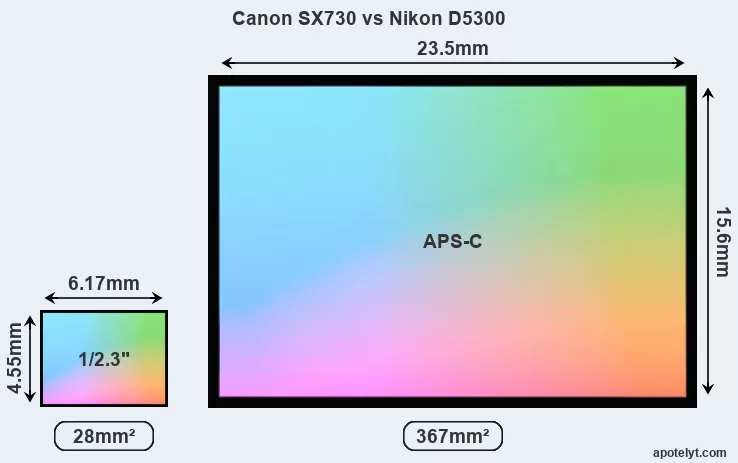
With 24MP, the D5300 offers a higher resolution than the SX730 (20.2MP), but the D5300 nevertheless has larger individual pixels (pixel pitch of 3.91μm versus 1.18μm for the SX730) due to its larger sensor. However, the SX730 is a much more recent model (by 3 years and 5 months) than the D5300, and its sensor will have benefitted from technological advances during this time that enhance the light gathering capacity of its pixel-units. Coming back to sensor resolution, it should be mentioned that neither of the two cameras has an anti-alias filter installed, so they are able to capture all the detail the sensor resolves.
The resolution advantage of the Nikon D5300 implies greater flexibility for cropping images or the possibility to print larger pictures. The maximum print size of the D5300 for good quality output (200 dots per inch) amounts to 30 x 20 inches or 76.2 x 50.8 cm, for very good quality (250 dpi) 24 x 16 inches or 61 x 40.6 cm, and for excellent quality (300 dpi) 20 x 13.3 inches or 50.8 x 33.9 cm. The corresponding values for the Canon SX730 are 25.9 x 19.4 inches or 65.8 x 49.4 cm for good quality, 20.7 x 15.6 inches or 52.7 x 39.5 cm for very good quality, and 17.3 x 13 inches or 43.9 x 32.9 cm for excellent quality prints.
The Canon PowerShot SX730 HS has a native sensitivity range from ISO 80 to ISO 3200. The corresponding ISO settings for the Nikon D5300 are ISO 100 to ISO 12800, with the possibility to increase the ISO range to 100-25600.
In terms of underlying technology, the SX730 is build around a BSI-CMOS sensor, while the D5300 uses a CMOS imager. Both cameras use a Bayer filter for capturing RGB colors on a square grid of photosensors. This arrangement is found in most digital cameras.
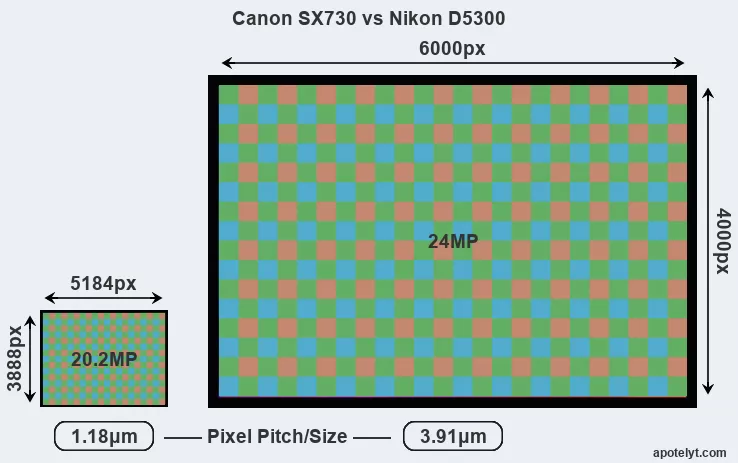
Since 2007, DXO Mark has published sensor performance measurements that have been derived using a consistent methodology. This service determines an overall sensor rating, as well as sub-scores for low-light sensitivity ("DXO Sports"), dynamic range ("DXO Landscape"), and color depth ("DXO Portrait"). The following table provides an overview of the physical sensor characteristics, as well as the sensor quality measurements for a selection of comparators.

| Camera Model |
Sensor Class |
Resolution (MP) |
Horiz. Pixels |
Vert. Pixels |
Video Format |
DXO Portrait |
DXO Landscape |
DXO Sports |
DXO Overall |
||
|---|---|---|---|---|---|---|---|---|---|---|---|
| 1. | Canon SX730 | 1/2.3 | 20.2 | 5184 | 3888 | 1080/60p | 20.5 | 11.9 | 924 | 50 | |
| 2. | Nikon D5300 | APS-C | 24.0 | 6000 | 4000 | 1080/60p | 24.0 | 13.9 | 1338 | 83 | |
| 3. | Canon G7 X Mark II | 1-inch | 20.0 | 5472 | 3648 | 1080/60p | 21.8 | 11.9 | 260 | 62 | |
| 4. | Canon SX420 | 1/2.3 | 19.9 | 5152 | 3864 | 720/25p | 20.3 | 11.7 | 806 | 48 | |
| 5. | Canon SX430 | 1/2.3 | 19.9 | 5152 | 3864 | 720/25p | 20.5 | 11.9 | 900 | 49 | |
| 6. | Canon SX540 | 1/2.3 | 20.2 | 5184 | 3888 | 1080/60p | 20.3 | 11.7 | 806 | 48 | |
| 7. | Canon SX710 | 1/2.3 | 20.2 | 5184 | 3888 | 1080/60p | 20.2 | 11.6 | 712 | 47 | |
| 8. | Canon SX720 | 1/2.3 | 20.2 | 5184 | 3888 | 1080/60p | 20.3 | 11.8 | 817 | 48 | |
| 9. | Canon SX740 | 1/2.3 | 20.2 | 5184 | 3888 | 4K/30p | 20.6 | 12.1 | 1050 | 51 | |
| 10. | Nikon D3200 | APS-C | 24.1 | 6016 | 4000 | 1080/30p | 24.1 | 13.2 | 1131 | 81 | |
| 11. | Nikon D3300 | APS-C | 24.0 | 6000 | 4000 | 1080/60p | 24.3 | 12.8 | 1385 | 82 | |
| 12. | Nikon D5200 | APS-C | 24.0 | 6000 | 4000 | 1080/60i | 24.2 | 13.9 | 1284 | 84 | |
| 13. | Nikon D5500 | APS-C | 24.0 | 6000 | 4000 | 1080/60p | 24.1 | 14.0 | 1438 | 84 | |
| 14. | Nikon D5600 | APS-C | 24.0 | 6000 | 4000 | 1080/60p | 24.1 | 14.0 | 1306 | 84 | |
| 15. | Panasonic TS7 | 1/2.3 | 20.2 | 5184 | 3888 | 4K/30p | 20.6 | 12.1 | 1028 | 51 | |
| 16. | Panasonic ZS70 | 1/2.3 | 20.2 | 5184 | 3888 | 4K/30p | 19.1 | 10.6 | 106 | 36 | |
| 17. | Sony HX99 | 1/2.3 | 18.0 | 4896 | 3672 | 4K/30p | 20.6 | 12.1 | 1058 | 51 | |
| Note: DXO values in italics represent estimates based on sensor size and age. | |||||||||||
Many modern cameras cannot only take still pictures, but also record videos. Both cameras under consideration are equipped with sensors that have a sufficiently high read-out speed for moving images, and both provide the same movie specifications (1080/60p).
Feature comparison
Apart from body and sensor, cameras can and do differ across a range of features. For example, the D5300 has an optical viewfinder, which can be very useful when shooting in bright sunlight. In contrast, the SX730 relies on live view and the rear LCD for framing. The following table reports on some other key feature differences and similarities of the Canon SX730, the Nikon D5300, and comparable cameras.

| Camera Model |
Viewfinder (Type or 000 dots) |
Control Panel (yes/no) |
LCD Specifications (inch/000 dots) |
LCD Attach- ment |
Touch Screen (yes/no) |
Max Shutter Speed * |
Max Shutter Flaps * |
Built-in Flash (yes/no) |
Built-in Image Stab |
||
|---|---|---|---|---|---|---|---|---|---|---|---|
| 1. | Canon SX730 | none | n | 3.0 / 922 | tilting | n | 1/3200s | 5.9/s | Y | Y | |
| 2. | Nikon D5300 | optical | n | 3.2 / 1037 | swivel | n | 1/4000s | 5.0/s | Y | n | |
| 3. | Canon G7 X Mark II | none | n | 3.0 / 1040 | tilting | Y | 1/2000s | 8.0/s | Y | Y | |
| 4. | Canon SX420 | none | n | 3.0 / 230 | fixed | n | 1/4000s | 0.5/s | Y | Y | |
| 5. | Canon SX430 | none | n | 3.0 / 230 | fixed | n | 1/4000s | 0.5/s | Y | Y | |
| 6. | Canon SX540 | none | n | 3.0 / 461 | fixed | n | 1/2000s | 5.9/s | Y | Y | |
| 7. | Canon SX710 | none | n | 3.0 / 922 | fixed | n | 1/3200s | 6.0/s | Y | Y | |
| 8. | Canon SX720 | none | n | 3.0 / 922 | fixed | n | 1/3200s | 5.9/s | Y | Y | |
| 9. | Canon SX740 | none | n | 3.0 / 922 | tilting | n | 1/3200s | 10.0/s | Y | Y | |
| 10. | Nikon D3200 | optical | n | 3.0 / 921 | fixed | n | 1/4000s | 4.0/s | Y | n | |
| 11. | Nikon D3300 | optical | n | 3.0 / 921 | fixed | n | 1/4000s | 5.0/s | Y | n | |
| 12. | Nikon D5200 | optical | n | 3.0 / 921 | swivel | n | 1/4000s | 5.0/s | Y | n | |
| 13. | Nikon D5500 | optical | n | 3.2 / 1037 | swivel | Y | 1/4000s | 5.0/s | Y | n | |
| 14. | Nikon D5600 | optical | n | 3.2 / 1037 | swivel | Y | 1/4000s | 5.0/s | Y | n | |
| 15. | Panasonic TS7 | 1170 | n | 3.0 / 1040 | fixed | n | 1/1300s | 10.0/s | Y | Y | |
| 16. | Panasonic ZS70 | 1166 | n | 3.0 / 1040 | tilting | Y | 1/2000s | 10.0/s | Y | Y | |
| 17. | Sony HX99 | 638 | n | 3.0 / 922 | tilting | Y | 1/2000s | 10.0/s | Y | Y | |
| Note: *) Information refers to the mechanical shutter, unless the camera only has an electronic one. | |||||||||||
The Nikon D5300 has an intervalometer built-in. This enables the photographer to capture time lapse sequences, such as flower blooming, a sunset or moon rise, without purchasing an external camera trigger and related software.
Concerning the storage of imaging data, both the SX730 and the D5300 write their files to SDXC cards. The D5300 supports UHS-I cards (Ultra High Speed data transfer of up to 104 MB/s), while the SX730 cannot take advantage of Ultra High Speed SD cards.
Connectivity comparison
For some imaging applications, the extent to which a camera can communicate with its environment can be an important aspect in the camera decision process. The table below provides an overview of the connectivity of the Canon PowerShot SX730 HS and Nikon D5300 and, in particular, the interfaces the cameras (and selected comparators) provide for accessory control and data transfer.

| Camera Model |
Hotshoe Port |
Internal Mic / Speaker |
Microphone Port |
Headphone Port |
HDMI Port |
USB Port |
WiFi Support |
NFC Support |
Bluetooth Support |
||
|---|---|---|---|---|---|---|---|---|---|---|---|
| 1. | Canon SX730 | - | stereo / mono | - | - | micro | 2.0 | Y | Y | Y | |
| 2. | Nikon D5300 | Y | stereo / mono | Y | - | mini | 2.0 | Y | - | - | |
| 3. | Canon G7 X Mark II | - | stereo / mono | - | - | micro | 2.0 | Y | Y | - | |
| 4. | Canon SX420 | - | mono / mono | - | - | - | 2.0 | Y | Y | - | |
| 5. | Canon SX430 | - | mono / mono | - | - | - | 2.0 | Y | Y | - | |
| 6. | Canon SX540 | - | stereo / mono | - | - | mini | 2.0 | Y | Y | - | |
| 7. | Canon SX710 | - | stereo / mono | - | - | micro | 2.0 | Y | Y | - | |
| 8. | Canon SX720 | - | stereo / mono | - | - | micro | 2.0 | Y | Y | - | |
| 9. | Canon SX740 | - | stereo / mono | - | - | micro | 2.0 | Y | - | Y | |
| 10. | Nikon D3200 | Y | mono / mono | Y | - | mini | 2.0 | - | - | - | |
| 11. | Nikon D3300 | Y | mono / mono | Y | - | mini | 2.0 | - | - | - | |
| 12. | Nikon D5200 | Y | stereo / mono | Y | - | mini | 2.0 | - | - | - | |
| 13. | Nikon D5500 | Y | stereo / mono | Y | - | mini | 2.0 | Y | - | - | |
| 14. | Nikon D5600 | Y | stereo / mono | Y | - | mini | 2.0 | Y | Y | Y | |
| 15. | Panasonic TS7 | - | stereo / mono | - | - | micro | 2.0 | Y | - | - | |
| 16. | Panasonic ZS70 | - | stereo / mono | - | - | micro | 2.0 | Y | - | - | |
| 17. | Sony HX99 | - | stereo / mono | - | - | micro | 2.0 | Y | Y | Y |
It is notable that the D5300 has a microphone port, which can help to improve the quality of audio recordings by attaching an external microphone. The SX730 does not feature such a mic input.
Travel and landscape photographers will find it useful that the D5300 has an internal geolocalization sensor and can record GPS coordinates in its EXIF data.
Both the SX730 and the D5300 have been discontinued, but can regularly be found used on ebay. The D5300 was replaced by the Nikon D5500, while the SX730 was followed by the Canon SX730 HS. Further information on the features and operation of the SX730 and D5300 can be found, respectively, in the Canon SX730 Manual (free pdf) or the online Nikon D5300 Manual.
Review summary
So what conclusions can be drawn? Is there a clear favorite between the Canon SX730 and the Nikon D5300? Which camera is better? The listing below highlights the relative strengths of the two models.

Arguments in favor of the Canon PowerShot SX730 HS:
- Faster burst: Shoots at higher frequency (5.9 vs 5 flaps/sec) to capture the decisive moment.
- Ready to shoot: Comes with a built-in lens, while the D5300 requires a separate lens.
- More compact: Is smaller (110x64mm vs 125x98mm) and thus needs less room in the bag.
- Less heavy: Is lighter even though it comes with a built-in lens (unlike the D5300).
- Easier travel charging: Can be conveniently charged via its USB port.
- Sharper images: Has hand-shake reducing image stabilization built-in.
- Easier device pairing: Supports NFC for fast wireless image transfer over short distances.
- Easier wireless transfer: Supports Bluetooth for image sharing without cables.
- More affordable: Was introduced at a lower price, despite coming with a built-in lens.
- More modern: Reflects 3 years and 5 months of technical progress since the D5300 launch.

Advantages of the Nikon D5300:
- More detail: Has more megapixels (24 vs 20.2MP), which boosts linear resolution by 11%.
- Better image quality: Features bigger pixels on a larger sensor for higher quality imaging.
- Richer colors: The pixel size advantage translates into images with better, more accurate colors.
- More dynamic range: Larger pixels capture a wider spectrum of light and dark details.
- Better low-light sensitivity: Larger pixels means good image quality even under poor lighting.
- Better sound: Can connect to an external microphone for higher quality sound recording.
- Easier framing: Has an optical viewfinder for image composition and settings control.
- Larger screen: Has a bigger rear LCD (3.2" vs 3.0") for image review and settings control.
- More detailed LCD: Has a higher resolution rear screen (1037k vs 922k dots).
- More flexible LCD: Has a swivel screen for odd-angle shots in portrait or landscape orientation.
- Faster shutter: Has higher mechanical shutter speed (1/4000s vs 1/3200s) to freeze action.
- Easier time-lapse photography: Has an intervalometer built-in for low frequency shooting.
- More flexible: Makes it possible to change lenses and thus to use specialty optics.
- Longer lasting: Gets more shots (600 versus 250) out of a single battery charge.
- Better lighting: Features a hotshoe and can thus hold and trigger an external flash gun.
- Easier geotagging: Features an internal GPS sensor to log localization data.
- Faster buffer clearing: Has an SD card interface that supports the UHS-I standard.
- More heavily discounted: Has been around for much longer (launched in October 2013).
If the count of relative strengths (bullet points above) is taken as a measure, the D5300 is the clear winner of the contest (18 : 10 points). However, the relevance of individual strengths will vary across photographers, so that you might want to apply your own weighing scheme to the summary points when reflecting and deciding on a new camera. A professional wedding photographer will view the differences between cameras in a way that diverges from the perspective of a travel photog, and a person interested in cityscapes has distinct needs from a macro shooter. Hence, the decision which camera is best and worth buying is often a very personal one.
How about other alternatives? Do the specifications of the Canon SX730 and the Nikon D5300 place the cameras among the top in their class? Find out in the latest Best Superzoom Camera and Best DSLR Camera listings whether the two cameras rank among the cream of the crop.
In any case, while the specs-based evaluation of cameras can be instructive in revealing their potential as photographic tools, it says little about, for example, the shooting experience and imaging performance of the SX730 and the D5300 in practical situations. User reviews that are available, for instance, at amazon can sometimes shed light on these issues, but such feedback is all too often partial, inconsistent, and inaccurate.
Expert reviews
This is why hands-on reviews by experts are important. The adjacent summary-table relays the overall verdicts of several of the most popular camera review sites (amateurphotographer [AP], cameralabs [CL], digitalcameraworld [DCW], dpreview [DPR], ephotozine [EPZ], photographyblog [PB]). As can be seen, the professional reviewers agree in many cases on the quality of different cameras, but sometimes their assessments diverge, reinforcing the earlier point that a camera decision is often a very personal choice.

| Camera Model |
AP score |
CL score |
DCW score |
DPR score |
EPZ score |
PB score |
Camera Launch |
Launch Price (USD) |
Street Price |
||
|---|---|---|---|---|---|---|---|---|---|---|---|
| 1. | Canon SX730 | .. | + | .. | .. | 4/5 | 4/5 | Apr 2017 | 399 | ebay.com | |
| 2. | Nikon D5300 | 4/5 | + + | .. | 79/100 | 4.5/5 | 4.5/5 | Oct 2013 | 799 | ebay.com | |
| 3. | Canon G7 X Mark II | 4.5/5 | + + | .. | 81/100 | 4.5/5 | 4.5/5 | Feb 2016 | 699 | ebay.com | |
| 4. | Canon SX420 | .. | .. | .. | .. | .. | 3/5 | Jan 2016 | 299 | ebay.com | |
| 5. | Canon SX430 | .. | .. | .. | .. | 3.5/5 | 3.5/5 | Jan 2017 | 299 | ebay.com | |
| 6. | Canon SX540 | .. | .. | .. | .. | .. | .. | Jan 2016 | 399 | ebay.com | |
| 7. | Canon SX710 | .. | + | .. | .. | 4/5 | 3.5/5 | Jan 2015 | 349 | ebay.com | |
| 8. | Canon SX720 | .. | + | .. | .. | 4/5 | 4.5/5 | Feb 2016 | 379 | ebay.com | |
| 9. | Canon SX740 | .. | + | 3.5/5 | .. | 4/5 | 4/5 | Jul 2018 | 399 | amazon.com | |
| 10. | Nikon D3200 | 5/5 | + + | .. | 73/100 | 4.5/5 | 4.5/5 | Apr 2012 | 599 | ebay.com | |
| 11. | Nikon D3300 | 3/5 | + | .. | 77/100 | 4.5/5 | 4.5/5 | Jan 2014 | 499 | ebay.com | |
| 12. | Nikon D5200 | 4/5 | + + | .. | 79/100 | 4.5/5 | 4.5/5 | Nov 2012 | 749 | ebay.com | |
| 13. | Nikon D5500 | 5/5 | + | .. | 79/100 | 4.5/5 | 4.5/5 | Jan 2015 | 899 | ebay.com | |
| 14. | Nikon D5600 | 4/5 | .. | 4/5 | 79/100 | 4.5/5 | 4/5 | Nov 2016 | 699 | ebay.com | |
| 15. | Panasonic TS7 | .. | + | .. | .. | .. | 3.5/5 | May 2018 | 449 | ebay.com | |
| 16. | Panasonic ZS70 | .. | + + | .. | .. | 4/5 | 4/5 | Apr 2017 | 449 | ebay.com | |
| 17. | Sony HX99 | .. | .. | .. | .. | 4/5 | 4.5/5 | Aug 2018 | 449 | ebay.com | |
| Note: (+ +) highly recommended; (+) recommended; (o) reviewed; (..) not available. | |||||||||||
The review scores listed above should be treated with care, though. The ratings are only valid when referring to cameras in the same category and of the same age. Thus, a score needs to be put into the context of the launch date and the launch price of the camera, and comparing ratings of very distinct cameras or ones that are far apart in terms of their release date have little meaning. It should also be noted that some of the review sites have over time altered the way they render their verdicts.

Check SX730 offers at
ebay.com

Check D5300 offers at
ebay.com
Other camera comparisons
Did this review help to inform your camera decision process? In case you would like to check on the differences and similarities of other camera models, just use the search menu below. As an alternative, you can also directly jump to any one of the listed comparisons that were previously generated by the CAM-parator tool.
- Canon 450D vs Canon SX730
- Canon 5DS vs Canon SX730
- Canon 7D II vs Canon SX730
- Canon 80D vs Canon SX730
- Canon SX730 vs Olympus E-M10 IV
- Canon SX730 vs Panasonic GM5
- Canon T3i vs Nikon D5300
- Canon XSi vs Nikon D5300
- Fujifilm X-E2 vs Nikon D5300
- Nikon D5300 vs Panasonic G6
- Nikon D5300 vs Sony A6100
- Nikon D5300 vs Sony RX100 III
Specifications: Canon SX730 vs Nikon D5300
Below is a side-by-side comparison of the specs of the two cameras to facilitate a quick review of their differences and common features.
| Camera Model | Canon SX730 | Nikon D5300 |
|---|---|---|
| Camera Type | Fixed lens compact camera | Digital single lens reflex |
| Camera Lens | 24-960mm f/3.3-6.9 | Nikon F mount lenses |
| Launch Date | April 2017 | October 2013 |
| Launch Price | USD 399 | USD 799 |
| Sensor Specs | Canon SX730 | Nikon D5300 |
| Sensor Technology | BSI-CMOS | CMOS |
| Sensor Format | 1/2.3" Sensor | APS-C Sensor |
| Sensor Size | 6.17 x 4.55 mm | 23.5 x 15.6 mm |
| Sensor Area | 28.0735 mm2 | 366.6 mm2 |
| Sensor Diagonal | 7.7 mm | 28.2 mm |
| Crop Factor | 5.6x | 1.5x |
| Sensor Resolution | 20.2 Megapixels | 24 Megapixels |
| Image Resolution | 5184 x 3888 pixels | 6000 x 4000 pixels |
| Pixel Pitch | 1.18 μm | 3.91 μm |
| Pixel Density | 71.80 MP/cm2 | 6.55 MP/cm2 |
| Moiré control | no AA filter | no AA filter |
| Movie Capability | 1080/60p Video | 1080/60p Video |
| ISO Setting | 80 - 3,200 ISO | 100 - 12,800 ISO |
| ISO Boost | no Enhancement | 100 - 25,600 ISO |
| Image Processor | DIGIC 6 | EXPEED 4 |
| DXO Sensor Quality (score) | .. | 83 |
| DXO Color Depth (bits) | .. | 24.0 |
| DXO Dynamic Range (EV) | .. | 13.9 |
| DXO Low Light (ISO) | .. | 1338 |
| Screen Specs | Canon SX730 | Nikon D5300 |
| Viewfinder Type | no viewfinder | Optical viewfinder |
| Viewfinder Field of View | 95% | |
| Viewfinder Magnification | 0.57x | |
| LCD Framing | Live View | Live View |
| Rear LCD Size | 3.0inch | 3.2inch |
| LCD Resolution | 922k dots | 1037k dots |
| LCD Attachment | Tilting screen | Swivel screen |
| Shooting Specs | Canon SX730 | Nikon D5300 |
| Focus System | Contrast-detect AF | Phase-detect AF |
| Continuous Shooting | 5.9 shutter flaps/s | 5 shutter flaps/s |
| Time-Lapse Photography | no Intervalometer | Intervalometer built-in |
| Fill Flash | Built-in Flash | Built-in Flash |
| Storage Medium | SDXC cards | SDXC cards |
| Single or Dual Card Slots | Single card slot | Single card slot |
| UHS card support | no | UHS-I |
| Connectivity Specs | Canon SX730 | Nikon D5300 |
| External Flash | no Hotshoe | Hotshoe |
| USB Connector | USB 2.0 | USB 2.0 |
| HDMI Port | micro HDMI | mini HDMI |
| Microphone Port | no MIC socket | External MIC port |
| Wifi Support | Wifi built-in | Wifi built-in |
| Near-Field Communication | NFC built-in | no NFC |
| Bluetooth Support | Bluetooth built-in | no Bluetooth |
| Geotagging | no internal GPS | GPS built-in |
| Body Specs | Canon SX730 | Nikon D5300 |
| Battery Type | Canon NB-13L | Nikon EN-EL14a |
| Battery Life (CIPA) | 250 shots per charge | 600 shots per charge |
| In-Camera Charging | USB charging | no USB charging |
| Body Dimensions |
110 x 64 x 40 mm (4.3 x 2.5 x 1.6 in) |
125 x 98 x 76 mm (4.9 x 3.9 x 3.0 in) |
| Camera Weight | 300 g (10.6 oz) | 480 g (16.9 oz) |

Check SX730 offers at
ebay.com

Check D5300 offers at
ebay.com
Did you notice an error on this page? If so, please get in touch, so that we can correct the information.

